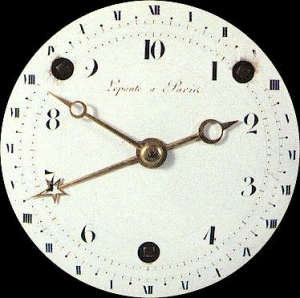The introduction of our Ford’s first T-Model …. Chosen as the opening date of the new era. All crosses had their tops cut and became T’s.
—Aldous Huxley, Brave New World
To begin with, he did not know with any certainty that this was 1984.
—George Orwell, 1984
 Chronology and the Year Zero
Chronology and the Year Zero
For five years Cambodia was racked by civil war. Then on April 17, 1975 the Khmer Rogue took Phnom Penh, the nation’s capital. The Khmer Rouge was an army of Cambodian peasant soldiers, mostly young people. They were directed by the Angka Loeu, a group of teachers and bureaucrats, pseudo-intellectuals, who had become dyed-in-the-wool Marxists while studying in Paris in the 1950s. The goal of this group was to reduce Cambodia to an agrarian economy without class division, money, or commerce. There would be no more schools or universities, no religion, no private property. And so the cities were emptied; their people were driven out into agrarian work camps, “the killing fields,” where they died by the hundreds of thousands. Schools and hospitals were shut down. Books were burned. Temples, mosques, and churches were destroyed. Teachers, doctors, technicians, those with any sort of education, were tortured to death. Anyone and anything that reflected Western influence had to be destroyed. That included Phnom Penh itself since, by its very existence, it promoted capitalist culture and Western imperialism. Journalist Lek Hor Tan writes:
Like the citizens of Oceania in 1984, the ‘new people’ had to be totally cut off from the past or any contacts with the outside world. The past was to be obliterated so that the purity of the future could be absolute—the ideal of complete oblivion. This included the changing of people’s names, so that the new man could forget everything, the country’s past history, dead ancestors, the names of places, traditional and national customs. Like Orwell’s “Big Brother,” Angka Loeu wanted to nationalize the personal and collective memory of its people so that they would become perfectly malleable and controllable. (The Index on Censorship, 1/84).
This project cost the lives of 1.7 million people, about 20% of the country’s population. Pol Pot, the leader of the Angka Loeu, gave a name to this time of social “regeneration”—he called it the Year Zero. As he saw it, history was starting afresh. But as we will see, this savage attempt to restart a nation’s history and chronology is not without historical precedent.
Revolution and Calendars
Amid the horror and slaughter of the French Revolution, the National Convention took the time to reinvent the calendar. The Convention restarted the timeline of French history, making the first year of the Revolution the Year 1. The mathematicians and poets who fleshed out the calendar’s details claimed that their great work “reflected the rationality and simplicity of Nature.” The calendar’s first day was the autumnal equinox, the time when day and night are equal, the time when the sun passes from one hemisphere to the other, an appropriate symbol of a great change. The revised year fell into four seasons of three months each. The calendar eliminated the seven-day week and divided its new months into décades of 10 days each. Gone were Sundays and holy days; in their place stood a new schedule of holidays, most named after a farm implement or animal. At the same time, the National Convention approved a new clock that divided the day into ten hours, the hour into 100 minutes, and the minute into 100 seconds. All of this stood in place until Napoleon abolished it in 1805. (He had chronological considerations of his own.)
The rallying cry of the French Revolution was, “Liberty, Equality, Fraternity, or Death!” With such weighty concerns on its hands—as well as the blood of 40,000 human beings, why did the revolutionary government bother with calendars and clocks? It is a question worth asking.
Chronology, Identity, and Narrative
We are defined by relationships—first of all, of course, by our relationship with God. But those defining relationships exist within a framework of geography and history. We are creatures of space and time, and our place in each is meaningful only in terms of context. Where on Earth are we? When are we? The first question must be answered in terms of a map or atlas, the second, in terms of a timeline. Places and dates set the parameters for relationships. They tell us whether or not A knew of B, could have met C, might have read D, or may have been influenced by E.
But places and dates do much more. By linking event to event, they make a meaningful narrative possible. A story or narrative requires temporal sequence. Cause must precede effect; one thing must lead to another. First, Frodo takes up the Ring, then he trudges towards Mordor, then he throws it into Mt. Doom. First, Elizabeth Bennet meets Mr. Darcy, then she despises him, then she learns to love him. Without temporal sequence, none of these plot elements would make any sense or have any meaning. It shouldn’t surprise anyone that books and websites devoted to Jane Austen provide chronologies for the storyline of Pride and Prejudice. Tolkien, of course, created his own chronology, not only for the War of the Ring, but for all of Middle-Earth. It’s in the appendices of The Return of the King.
While chronology does not, in itself, create or assign significance, it does make significance and meaning possible. The man who cannot give a coherent account of major events in his life can’t make sense of his life. Was it the military first and college later? Was the wedding before or after the war? Which child came first? When we can’t sequence the events, we can’t tell the story, and we can’t find the meaning. And if there is no meaning, we don’t know who we are. Our identity is tied to our chronology.
Chronology and Community
What is true of individuals is true of nations and cultures. A nation defines itself by the sequenced events of its history, that is to say, by its story. This means that the nation’s chronology is basic to its sense of community. Americans are those whose nation fought a War for Independence, tamed a frontier, survived a Brothers’ War, defeated the Nazis, and took man to the moon. This shared past is a significant part of what makes Americans … Americans. Take away the sequence, blur the chronology, deemphasize the events, and we don’t know who we are.
Key to any people’s story is their beginning. Americans look back to 1776—the French to 1789. Jewish scholars date creation at 3760 BC and track sacred history from Adam through Abraham to the Exodus using the chronology explicit in the Torah. Muslims date their civilization from the Hijra, Mohammed’s flight from Mecca to Medina in 622. Christians structure the chronology of Earth’s history around the birth of Jesus Christ. We label the years before His birth BC (before Christ) and those after His birth AD (anno Domini, Latin for “the year of our Lord”). This dating system not only recognizes Jesus of Nazareth as the center and focus of history, but explicitly names Him Christ (Messiah) and Lord. It acknowledges His ongoing reign in resurrection life and asserts His total sovereignty over the calendar history of this world.
With the waning cultural influence of the Christian faith, the BC/AD dating system is fast falling out of favor. The alternate designations, CE (Common Era) and BCE (Before Common Era), are rapidly replacing the older terms. Most churchmen have gone along passively, while a few have protested the change. In June of 2000, the Southern Baptist Convention passed a resolution denouncing the shift to CE/BCE. The Convention said the shift was “the result of the secularization, anti-supernaturalism, religious pluralism, and political correctness pervasive in our society.” Historian Lynn Hunt says it nicely: “The resolution is a good reminder that the means of marking time are still far from neutral” (Measuring Time, Making History, 2008). It is important to understand that time-keeping is a deeply religious project.
Chronology and Freedom
In Huxley’s Brave New World, the global government has restarted the calendar, dating forward from Ford’s invention of the Model-T, a symbol of the technological age. The past has been obliterated and all records, monuments, and museums are destroyed. The World State controls all the information its citizens receive, from embryo to grave. And appropriately enough, the World State’s motto is: “Community, Identity, Stability.”
The future Orwell foresaw was similar. In 1984 the government of Oceania has rewritten history and is constantly rewriting it according to the needs of the moment. The ruling Party insists that the past exists only in written records and in human memory. That is, in men’s minds. Since the Party controls both, it controls the past. With control of the past, comes control of the future:
O’Brien was looking down at him speculatively. More than ever he had the air of a teacher taking pains with a wayward but promising child.
“There is a Party slogan dealing with the control of the past,” he said. “Repeat it, if you please.”
“Who controls the past controls the future: who controls the present controls the past,” repeated Winston obediently.
With no knowledge of the past, the citizens of Oceania—like those of Huxley’s World State—have no identity, no community, no future, beyond the State itself. “There will be no loyalty, except loyalty towards the Party. There will be no love, except the love of Big Brother.” With the past, they have lost their future and their freedom.
Teaching Children History
Teaching history is essential to Christian civilization: the Old and New Testaments are full of commands to remember. The Bible itself is a book of history. The books that don’t explicitly relate historical events always presuppose them. The backbone of history is chronology. The backbone, but not the spirit. Both are necessary for history to live and breathe.
Students and teachers, too, often complain that their history classes are nothing but meaningless lists of names and dates. Too often the solution has been to drop the dates and teach the broad concepts. History gives way to social science, and a whole generation loses its grip on its identity. (Are your children learning real history or Orwellian social studies?)
But children can learn sequence. Children organize comic books by series and number, TV shows by season and episode, and movies by sequel number and scene. Many know by heart the chronology of Middle-Earth. There is nothing inherently difficult about teaching these same children a list of twenty or thirty significant events with their dates, providing there is an interwoven and overarching story that connects the dates and reveals their importance. History teachers need to be storytellers. Of course, that means they have to know and believe the Story.
Conclusion: Sacred Chronology
When Moses led the children of Israel out of Egypt, he recorded the date, which was 430 years after their forefathers began their sojourn (Ex. 12:21). Paul tells us that this means there are 430 years from Abraham’s entry into Canaan to the giving of the Law at Sinai several weeks after the Exodus (Gal. 3:17). The Book of Kings tells us that the Exodus was 480 years before the construction of Solomon’s Temple (1 Kings 6:1). God set the redemption of Israel firmly in a chronological context. He labeled it history, not mythology. And He ordained Passover as a yearly festival to remind Israel where they had come from and to point them forward to the climax of their story: the coming of the Messiah.
Sacred chronology tracks the history of the sacred within the temporal, material universe. This chronology is God’s testimony to His immanence, His intimate concern with the material world, and His sovereign control of Earth’s calendar history. It is a rejection of Gnosticism, Deism, and Neo-Orthodoxy. To the Post-Modern mind, this is crazy talk, ridiculous and absurd. To the prophets and apostles, this was the very heart of the Christian faith.
For Further Reading:
Cambodian Communities out of Crisis <https://www.cambcomm.org.uk/holocaust.html>
Peter Wilson, “Year Zero,” American Thinker, April 17, 2010 <https://www.americanthinker.com/peter_wilson/>
William Kirk Kilpatrick, Psychological Seduction, The Failure of Modern Psychology, ch. 8-9 (Nashville: Thomas Nelson Publishers, 1983).
Philip Mauro, The Wonders of Biblical Chronology (Sterling, VA: Grace Abounding Ministries, 1987).
James Jordan, “The Theology of Biblical Chronology,” Biblical Chronology, December 1989, Vol. 1, No. 3.
 Off The Grid News Better Ideas For Off The Grid Living
Off The Grid News Better Ideas For Off The Grid Living




